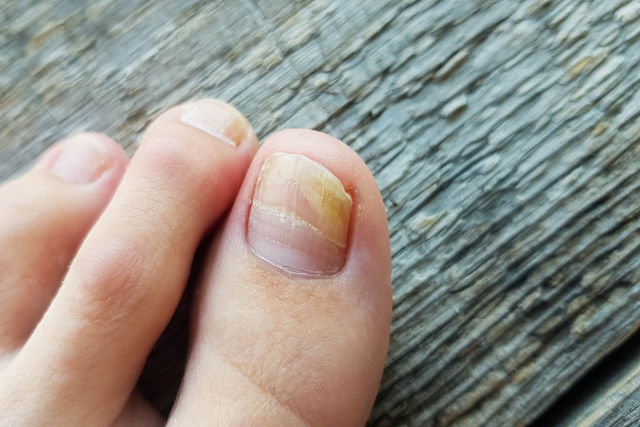Yellow nails mainly occur as a result of a fungal nail infection. These infections can alter the shape, texture and color of fingernails or toenails.
However, yellow nails can also be a result of normal aging, smoking or a nutritional deficiency, like a lack of vitamin A or vitamin C.
Yellow nails may be a sign of a health condition, like ungual psoriasis, and therefore you should report this finding to your doctor. The doctor will assess the affected nails as well as other symptoms to determine whether further treatment is required.

What causes yellowing of the nails?
The main causes of yellow nails are:
1. Fungal infection
Fungal nail infections, or onychomycosis, can cause changes to the color, shape or texture of the nail. Nail fungus often leaves finger or toenails thicker, deformed and yellow. This infection can be transmitted at the pool or in public locker rooms, where people are prone to walk barefoot. They can also be transmitted at nail salons through shared manicure tools.
What to do: Nail fungus can be treated with antifungal nail polishes or oral medications, which are used as directed by a dermatologist.
2. Vitamin or mineral deficiency
Nutritional deficiencies can leave many parts of the body, as well as the nails, more fragile, breaking and discolored. Yellow nails can be a result of a lack of antioxidants, like vitamin A or vitamin C.
What to do: Ideally, you should maintain a healthy, varied diet to prevent a vitamin or mineral deficiency. If necessary, a doctor or registered dietitian may recommend vitamin supplements, to be taken for at least 3 months.
3. Normal aging
As we get older, our nails become weaker and can become slightly more yellow. This is a natural aging process and does not indicate any health problems.
What to do: Applying hydrogen peroxide is a great way to brighten the nails. To make them stronger, you can apply a strengthening nail lacquer.
4. Using nail polish
Frequently using nail polish, particularly bright colors like red or orange, or keeping nail polish on the nails for a long time can give the nails a yellow color.
What to do: To prevent yellowing of the nails from nail polish, you should alternate periods of nail polish use with periods of bare nails. You should also use a base polish to protect the nail before applying a color polish.
5. Ungual psoriasis
Ungual psoriasis occurs when the body’s defense cells attack the finger or toenails. This can leave the nails wavy in texture, deformed, fragile, thick and spotted.
What to do: Although psoriasis is not curable, nail appearance can be improved with nail polishes that contain clobetasol and vitamin D. Some other home treatments may include hydrating the nails regularly and maintaining a diet that is rich in omega-3 foods, like flaxseeds, salmon and tuna.
6. Smoking
Smoking can increase the risk for many diseases, like bronchitis or emphysema, due to its high concentration of toxic substances, like nicotine. Nicotine can penetrate the skin, particularly the fingers and fingernails, and cause them to turn yellow.
What to do: Although there are treatments that can help brighten the nails, you are advised to stop smoking. This will help to improve nail and skin appearance and also the risk for developing more serious health conditions.
7. Liver problems
Yellow nails can also be the result of a liver problem. In these cases, in addition to yellow nails, you may also experience other symptoms like yellow skin and eyes, nausea, frequent dizziness and pain in the upper right part of the abdomen.
Learn more about the symptoms of liver disease and complete our online quiz to determine your risk for a liver problem.
What to do: Treatment depends on the underlying liver condition and therefore testing is usually ordered to identify the cause. Depending on the results, the doctor may advise changing eating habits, taking medication, surgery and, in the most serious cases, a liver transplant.
Also recommended: 13 Foods That Are Good For the Liver tuasaude.com/en/foods-that-are-good-for-the-liver8. Chronic kidney disease
Chronic kidney disease can also cause changes in the nails, as it can promote fungal cell development.. Furthermore, people with this disease may also have other changes in their nails, such as the presence of white dots or stripes on the nail and/or detachment of the nail from the skin, for example.
Read more about symptoms of kidney problems and complete our online quiz to determine your risk for a kidney condition.
What to do: it is important to consult a dermatologist for assessment to determine whether the yellow skin is related to the kidney issue. If kidney disease is confirmed, treatment should be monitored by a nephrologist to relieve symptoms and prevent disease progression.
9. Excess beta-carotene intake
Excessive consumption of foods that contain high amounts of beta-carotene can lead to carotenemia. Although it is rare, this situation is characterized by a yellow-orange color of the skin, which can also be noted on the nails.
Excess beta-carotene is more common in children, mainly because infant milk formulas are enriched with beta-carotene. Furthermore, when preparing purees, soups or cutting and cooking foods rich in beta-carotene, it is possible to increase their bioavailability. Some foods rich in beta-carotene are cherries, mango, watermelon, papaya and pumpkin.
What to do: in this case, it is important to consult a doctor to rule out other possible conditions. If carotenemia is confirmed, the doctor may advise temporarily reducing or suspending the consumption of foods rich in beta carotenes
